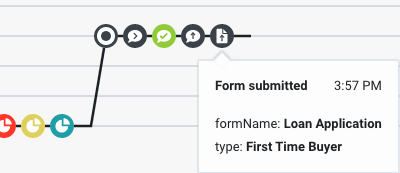Difference between revisions of "ATC/Current/AdminGuide/Web sessions"
(Published) |
(Published) |
||
| Line 3: | Line 3: | ||
|DisplayName=Web sessions | |DisplayName=Web sessions | ||
|TocName=Web sessions | |TocName=Web sessions | ||
| − | |Context=Learn how to capture information about | + | |Context=Learn how to capture information about visitor activity on your website and present it to agents. |
|Dimension=Session Library | |Dimension=Session Library | ||
|ComingSoon=Yes | |ComingSoon=Yes | ||
| Line 17: | Line 17: | ||
|anchor=WSOverview | |anchor=WSOverview | ||
|alignment=Vertical | |alignment=Vertical | ||
| − | |structuredtext=When you {{Link-AnywhereElse|product=ATC|version=Current|manual=AdminGuide|topic=About_tracking|display text=track your website with {{MINTYDOCSPRODUCT}}}}, we capture the history of web interactions. This history includes all the times and ways that | + | |structuredtext=When you {{Link-AnywhereElse|product=ATC|version=Current|manual=AdminGuide|topic=About_tracking|display text=track your website with {{MINTYDOCSPRODUCT}}}}, we capture the history of web interactions. This history includes all the times and ways that visitors visited and interacted with your website. |
| − | Each time a | + | Each time a visitor arrives on your website, a new web session begins. The web session ends when a visitor is inactive for 20 minutes or longer. |
|Status=No | |Status=No | ||
}}{{Section | }}{{Section | ||
| Line 25: | Line 25: | ||
|anchor=VerifyContacts | |anchor=VerifyContacts | ||
|alignment=Vertical | |alignment=Vertical | ||
| − | |structuredtext=When a | + | |structuredtext=When a visitor comes to your website, we attempt to verify their identity using their cookie. If no cookie is available, we attempt to verify their identity with identifiers that we collect from the web, such as phone or email.{{NoteFormat| |
*Successful verification requires a phone number in E164 format. | *Successful verification requires a phone number in E164 format. | ||
| − | *We do not create contacts from | + | *We do not create contacts from cookies. |
*We do add cookies to existing Genesys Cloud [https://help.mypurecloud.com/articles/?p=70936 external contacts].|}} | *We do add cookies to existing Genesys Cloud [https://help.mypurecloud.com/articles/?p=70936 external contacts].|}} | ||
| − | If you use the {{Link-SomewhereInThisVersion|manual=SDK|topic=Get_started|display text=Journey JavaScript SDK}} to capture a | + | If you use the {{Link-SomewhereInThisVersion|manual=SDK|topic=Get_started|display text=Journey JavaScript SDK}} to capture a visitor's personal data while they are on your website, it's possible for us to identify the visitor. For example, you can use <code>{{Link-SomewhereInThisVersion|manual=SDK|topic=Identify|display text=ac 'identify'}}</code> and {{Link-SomewhereInThisVersion|manual=SDK|topic=Traits_mapper|display text=map traits to link visitor records}}. |
| − | If we are unable to verify that the | + | If we are unable to verify that the visitor has a corresponding customer record, the visitor's name appears as "Unknown" in the session card. |
|Status=No | |Status=No | ||
}}{{Section | }}{{Section | ||
| Line 46: | Line 46: | ||
|anchor=WebSessionEvents | |anchor=WebSessionEvents | ||
|alignment=Vertical | |alignment=Vertical | ||
| − | |structuredtext=As a | + | |structuredtext=As a visitor navigates your website, {{MintyDocsProduct}} collects the following data about the visitor's activity during a web session. Agents can view this information in the web session card. You can use this data to create {{Link-SomewhereInThisVersion|manual=AdminGuide|topic=About_segments|display text=segments}}, {{Link-SomewhereInThisVersion|manual=AdminGuide|topic=About_outcomes|display text=outcomes}}, and {{Link-SomewhereInThisVersion|manual=AdminGuide|topic=About_action_maps|display text=action maps}} that orchestra future visitor journeys: |
*{{Link-SomewhereInThisVersion|manual=SDK|topic=Pageview|display text=Page views}} | *{{Link-SomewhereInThisVersion|manual=SDK|topic=Pageview|display text=Page views}} | ||
Revision as of 16:36, December 17, 2020
Contents
Feature coming soon!Learn how to capture information about visitor activity on your website and present it to agents.
Prerequisites
- Configure the following permissions in Genesys Cloud:
- To see custom sessions and custom events, assign agents specific permissions.
Overview
When you track your website with Genesys Predictive Engagement, we capture the history of web interactions. This history includes all the times and ways that visitors visited and interacted with your website.
Each time a visitor arrives on your website, a new web session begins. The web session ends when a visitor is inactive for 20 minutes or longer.
How we verify contacts on your website
- Successful verification requires a phone number in E164 format.
- We do not create contacts from cookies.
- We do add cookies to existing Genesys Cloud external contacts.
If you use the Journey JavaScript SDK to capture a visitor's personal data while they are on your website, it's possible for us to identify the visitor. For example, you can use ac 'identify' and map traits to link visitor records.
If we are unable to verify that the visitor has a corresponding customer record, the visitor's name appears as "Unknown" in the session card.
Web session type
We assign each web session the predefined web session type. You cannot change this type.
Web events
As a visitor navigates your website, Genesys Predictive Engagement collects the following data about the visitor's activity during a web session. Agents can view this information in the web session card. You can use this data to create segments, outcomes, and action maps that orchestra future visitor journeys:
For more information about tracking limits, see [[ATC/Limits|]].
For more information about web event tracking for billing purposes, see Billing and usage.
Custom web events
You can use the ac('record') method in the Journey JavaScript SDK to track custom web events.
For example:
- Button clicks (for example, add to cart, submit a form)
- Check out
- Play video
- In-page messaging (for example, wrong password, form errors)
ac('record').ac('record', 'form_submitted', { 'formName': 'Loan Application', 'type': 'First Time Buyer' }, () => {});Web session cards
Agents see a separate session card for each web session. The session card includes:
- Title
- Icon
- Duration
- Current page
- Session information
- Journey map
- Searches performed
- Segments matched during the session
- Outcomes achieved during the session
Configure web session cards
You can configure the appearance of the web session cards:
- Name that appears as the title on all web session cards (Ex: "Web Visit")
- Appearance of attributes in the tooltip


